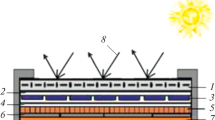Abstract—
The results of an anhydrous cleaning and cooling model of a photovoltaic battery (PVB) using the Venturi effect are presented. The Venturi tube is a truncated cone, the speed of air movement in which depends on its height and the ratio of the areas of bases δ. The highest air flow rate is achieved at 1 < δ ≤ 1.5. The limiting temperature of PVB cooling is practically independent of the pipe height. Air flow generated by the Venturi tube removes medium and fine dirt particles.



Similar content being viewed by others
REFERENCES
Mani, M. and Pillai, R., Impact of dust on solar photovoltaic (PV) performance: Research status, challenges and recommendations, Renewable Sustainable Energy Rev., 2010, vol. 14, p. 3124.https://doi.org/10.1016/j.rser.2010.07.065
Zhao, W., Lv, Y., Wei, Z., Van, W., and Zhou, Q., Review on dust deposition and cleaning methods for solar PV modules, Renewable Sustainable Energy, 2021, vol. 13, id. 032701. https://doi.org/10.1063/5.0053866
Saravanan, V.S. and Darvekar, S.K., Solar photovoltaic panels cleaning methods. A review, Int. J. Pure Appl. Math., 2018, vol. 118, no. 24, pp. 1–17.
Bakirov, M.Ya., Photovoltaic and radiation characteristics of silicon solar cells at high illumination and temperatures, Fiz. Tekh. Poluprovodnikov, 1997, vol. 31, no. 5, pp. 520–522.
Gul’kov, V.N., Kolesnichenko, I.D., and Korotkov, K. E., Study of the effect of heating solar modules on the efficiency of radiation conversion, Izv. S.-Peterb. Gos. Elektrotekh. Univ. LETI, 2019, no. 1, pp. 10–16.
Zhao, B., Hu, M., Ao, X., and Pei, G., Radiative cooling: A review of fundamentals, materials, applications, and prospects, Sol. Energy, 2019, vol. 236, pp. 489–513. https://doi.org/10.1016/j.apenergy.2018.12.018
Dyskin, V.G., Sabirov, Kh., Abdullaev, E.T., and Komolov, I.M., Cleaning the surface of a photovoltaic array with an air jet, Geliotekhnika, 2017, no. 3, pp. 19–24.
Tursunov, M.N., Dyskin, V.G., Turdiev, B.M., and Yuldashev, I.A., The influence of convective heat exchange on the temperature of a solarvoltaic array, Appl. Sol. Energy, 2014, vol. 50, no. 4, pp. 236–237.
Duffie, J.A. and Beckman, W.A., Solar Energy Thermal Processes, Hoboken, NJ: Wiley, 1974.
Reist, P., Introduction to Aerosol Science, New York: Macmillan, 1984.
TehTab.ru. Technical Tables. http://tehtab.ru/Guide/ GuidePhysics/Length/ParticleSizes.
Funding
The study was carried out on budget financing by the Ministry of Innovation and Development of the Republic of Uzbekistan.
Author information
Authors and Affiliations
Corresponding author
Ethics declarations
The author declares that he has no conflicts of interest.
About this article
Cite this article
Dyskin, V.G. On the Possibility of Cooling and Cleaning the Surface of a Photovoltaic Battery Using the Venturi Effect. Appl. Sol. Energy 57, 507–509 (2021). https://doi.org/10.3103/S0003701X21060074
Received:
Revised:
Accepted:
Published:
Issue Date:
DOI: https://doi.org/10.3103/S0003701X21060074




